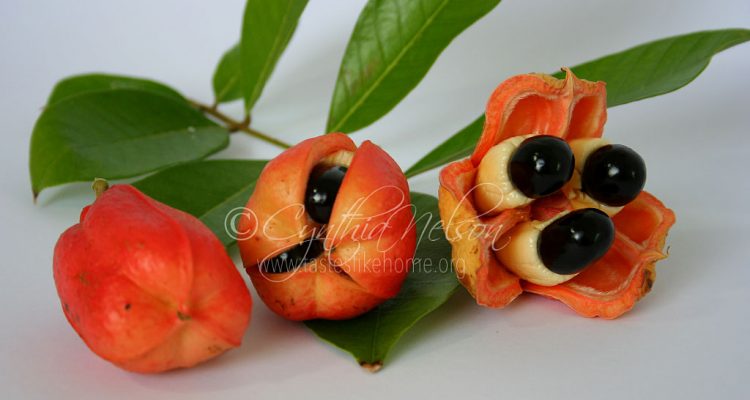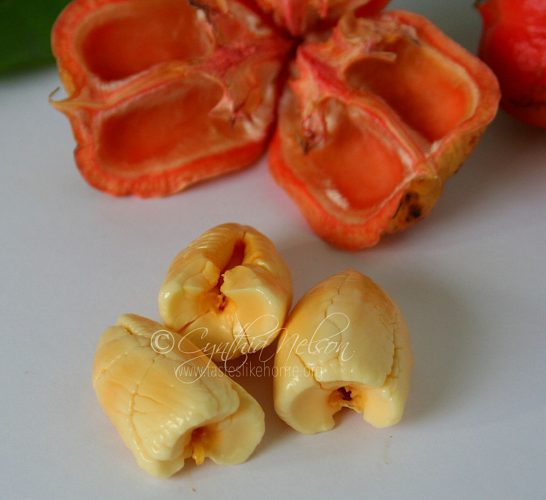 On my plate this week is Jamaica’s national dish, Ackee & Salt Fish.
On my plate this week is Jamaica’s national dish, Ackee & Salt Fish.
Last week I went to see the Bob Marley movie, “One Love”. And last Saturday after a drive through Barbados’ countryside visiting friends, I left their place with a hand of bananas picked from one of their trees that same afternoon and ackees. I knew exactly what I was having the next day for brunch: a plateful of Ackee & Salt fish – to be chased down with a big mug of lemongrass & bay leaf tea.
My first taste of ackee was more than 25 years ago whilst on a trip to Jamaica. I immediately fell in love with the dish, and fortunately, I can get fresh ackees here in Barbados. Each season, I look forward to eating the dish.

The ackee tree is an evergreen tree that’s native to West Africa and it thrives in tropical and sub-tropical environments. The tree was first taken to Jamaica in the 1700s probably on a slave trip. Today ackee trees can be found all over the island and ackees are touted as the second largest agricultural export. In 2022, revenue from exports are believed to have been over US$55 million from a combination of fresh and canned ackee.
Referred to as the national fruit of Jamaica, the ackee, when it begins to ripen, makes a colour transition from green to bright red to yellow-orange and splits open. When it splits open that’s when you know that the ackee is ripe and ready for the picking. The split outer shell reveals 3 large shiny black seeds attached at the bottom to a soft white to cream-coloured flesh. To clean the ackee, you remove the black seeds and the membrane which would be a soft pink tissue.
Like many fruits and vegetables, ackee is seasonal and peaks from December to March and then again from June to August, however, some people have staggered their planting of the ackee tree to facilitate fresh ackees being available all-year round.
Cooking ackee is quick work, it takes just about 5 minutes to cook through and it’s very important to not stir the ackees too much if not they will disintegrate and turn to mush. Therefore, when you’re cooking ackee, whether it is fresh or out of a can, you always want to add it last to the pot and to stir it only once. The ackees offer a visual cue when they are cooked, they turn a bright yellow.

Apart from being the national dish, ackee and salt fish is also a traditional Jamaican breakfast meal and it’s served with boiled green bananas, fried dumplings (similar to bakes) or fried plantains. When it’s served on the weekends, like Saturday for example, it’s eaten with boiled ground provisions such as yams and dasheen; if the ackee and salt fish are served with ground provisions however, the accompanying dumplings are boiled instead of fried. It’s a real treat to have with roast breadfruit and at morning weddings it is the meal of choice.
At Christmas time, ackee is served with smoked ham and sometimes, bacon. Yum! Actually, ackee and salt fish have spread beyond the realm of breakfast; it is enjoyed at any meal throughout the day. This meal has even moved into party-mode of cocktail appetizer not just because of its taste but also because it makes a striking presence. A riot of yellow, red and green sits atop small bammies (Jamaican cassava bread). My friend’s (Yanique) mom serves them in phyllo cups, that’s such a neat idea and definitely elevates the humble ackee and salt fish.
Although ackee is grown in other parts of the world and other Caribbean countries such as Haiti, Barbados, Cuba and Puerto Rico, it is Jamaica that this fruit and dish is mostly associated with. Those looking for a taste of home abroad or out of season can quickly satisfy that desire by reaching for a can of ackees. If you haven’t tried a plate of ackee and salt fish yet, don’t wait. Make it a priority.
Cynthia






